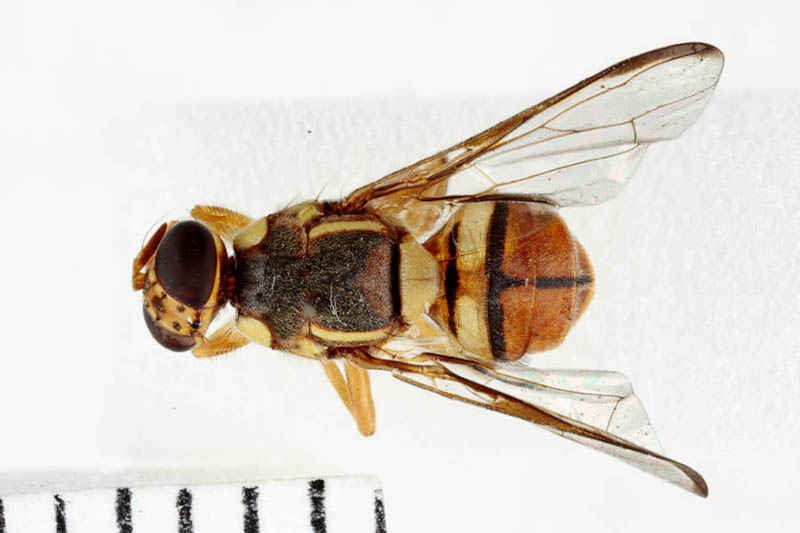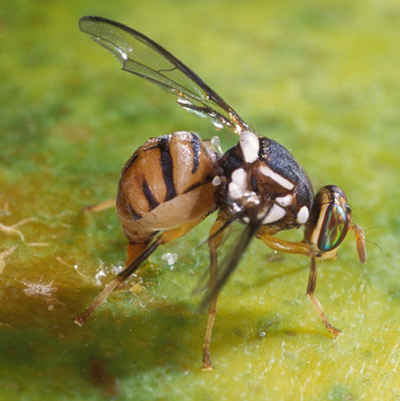A biosecurity operation is under way and extra field teams are today in Papatoetoe, Auckland, after the find of a single male Oriental fruit fly in a surveillance trap in a suburban backyard, says Biosecurity New Zealand Commissioner North Mike Inglis.
“Checks of the other 187 traps in the Papatoetoe/Mangere area did not find any fruit flies in them,” says Mr Inglis. “However, our previous experience with the successful eradication of several different types of fruit fly is that we might find other insects, so it is important we move quickly, look for any others and eradicate them.
“We will be ramping up trapping and testing, with daily checks in a 200-metre zone from the original find and three daily testing in a second zone out to 1500m,” Mr Inglis says.
“There have been 12 incursions of different fruit fly in Auckland and Northland since 1996 and all have been successfully eradicated thanks to the work of Biosecurity New Zealand, our horticulture partners, and local communities who have stepped up to help.”
Mr Inglis says the latest find demonstrates the benefit and effectiveness of MPI’s lure-based surveillance trapping network and the biosecurity system.
“Our trapping network involves some 7,878 traps set nationwide, and these are checked regularly.
“By setting traps for these pest insects, we are able to find them early, know exactly where the problem is, and respond quickly and effectively.”
Mr Inglis says the fruit fly poses no human health risk, but there would be an economic cost to the horticulture industry if it were allowed to establish here.
“The capture of a single male does not mean we have an outbreak. However, while we do our checks for any other fruit flies, we need community help to prevent any possible spread.
“As a precautionary measure, we’ll be putting legal restrictions in place on the movement of fruit and vegetables out of the area where the fruit fly was found.
“Instructions about these controls and the exact area affected will be issued by midday Sunday once we have completed an initial investigation. In the meantime, we ask that people who live and work in the suburb not take any whole fresh fruit and vegetables out of your property.”
Inglis says biosecurity staff will be out tomorrow providing people with information.
“You may notice increased activity in the neighbourhood as we go about inspections and trapping. Our field officers may ask to look at fruit trees on your property. They will always show you a form of official identification and will only enter your property with your permission.”
In addition to the field work, Biosecurity New Zealand is working closely with international trading partners and Government Industry Agreement (GIA) partners in the horticultural industry to minimise the risk to New Zealand growers and exporters.
Mr Inglis says Biosecurity New Zealand has among the strictest controls in the world for the importation of fruit and checks at the border. The most likely way that fruit flies can arrive in New Zealand is on fresh fruit and vegetables.
To report suspected finds of fruit fly, call MPI’s Pest and Diseases Hotline on 0800 80 99 66.
The Oriental fruit fly is native to Asia but has now spread to many warmer countries, especially as the climate warms. Adult flies lay eggs into fruit. The young stages (maggots) feed inside the fruit, causing it to rot and become unmarketable.
The Oriental fruit fly maggots can feed on 300 different fruit and vegetables. The fly’s favourite hosts are apple, guava, mango, peach, and pear.
How to identify the fly
Adult flies:
- are a little larger than a housefly (6mm to 8mm long)
- have a dark “T” shaped marking on the abdomen (the part behind the waist)
- usually have a bright yellow and orange abdomen (but can vary)
have clear wings.

The female fly has a pointed “sting” to lay eggs inside fruit (but she can’t sting or bite people). The male fruit fly is a similar size but is reddish-brown.

If you think you’ve found the fruit fly
- photograph it
- capture it (if you can)
- call MPI on 0800 80 99 66
I’m in favour of a mass genocide of ALL flies. Every single one. Don’t care how much it would upset the eco-nerds.
They are Satan’s budgies. Kill them all. With fire.
:}
How would nature get rid of your mass/mess if not for flies?
You gotta give it to them, they are the most astonishing flying survival machines.
Parasites however………..